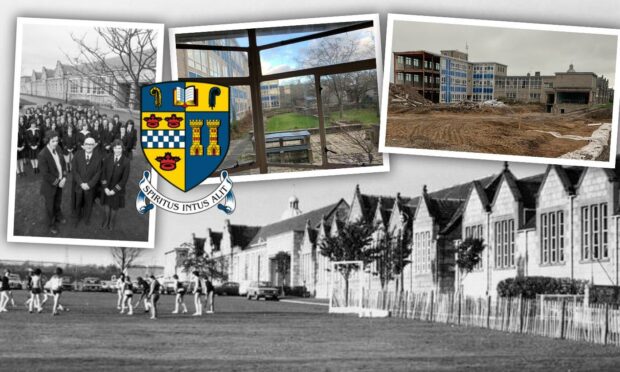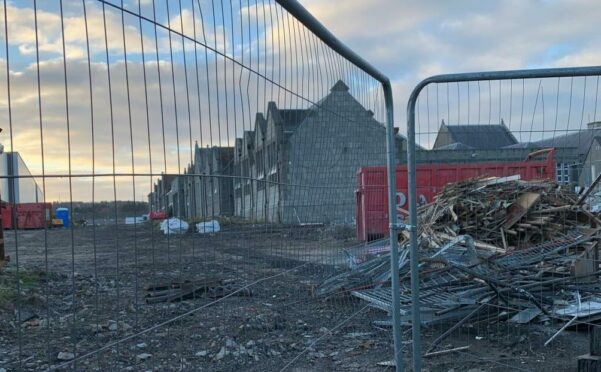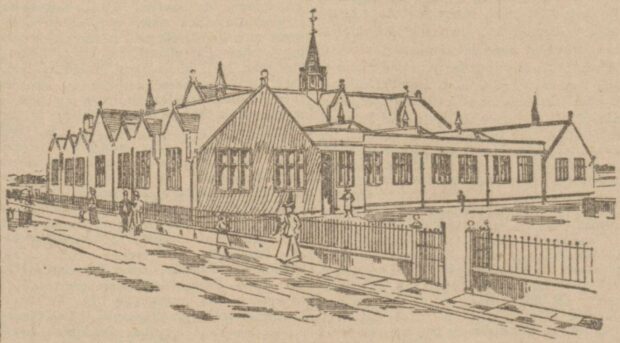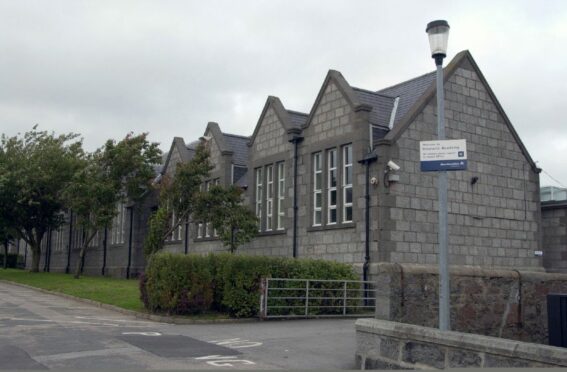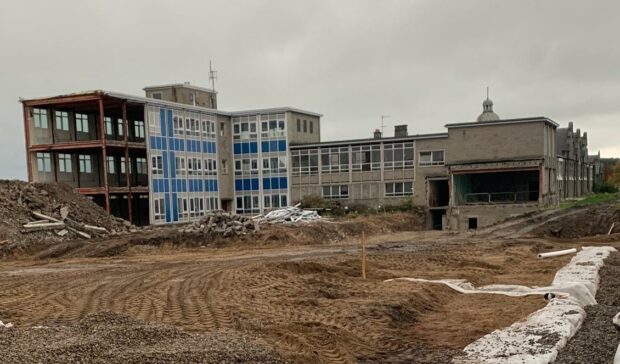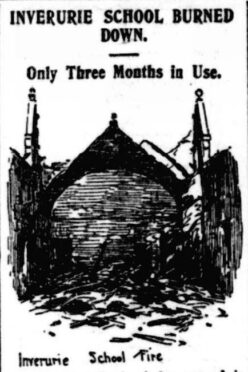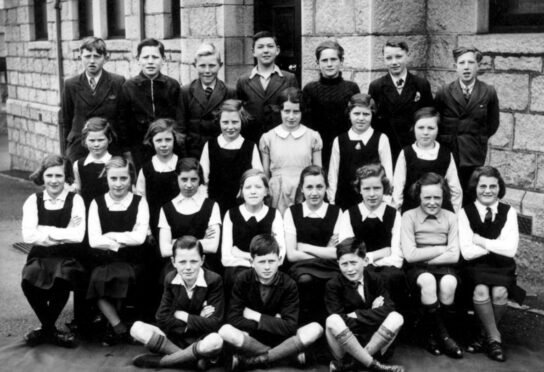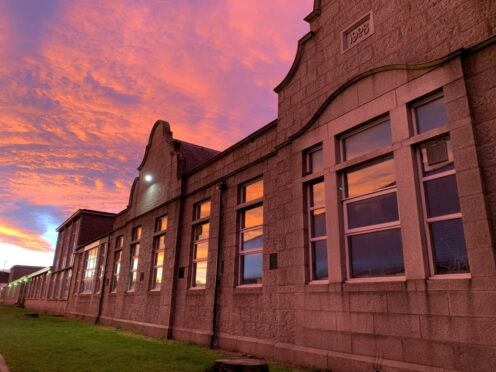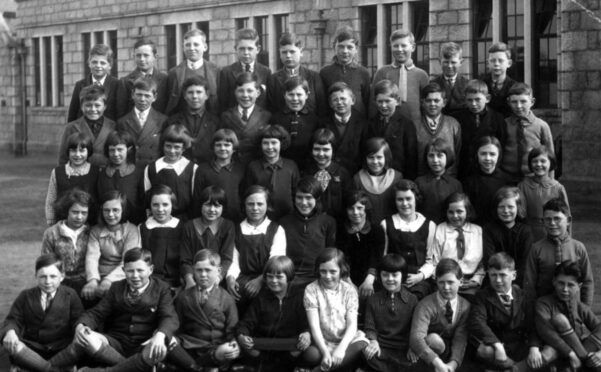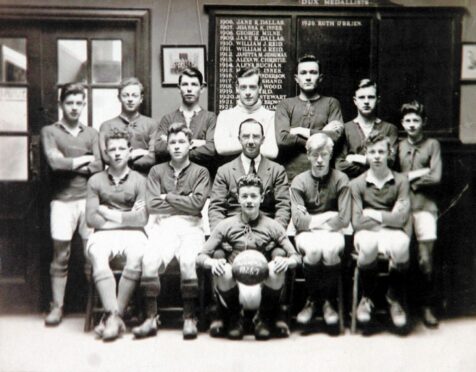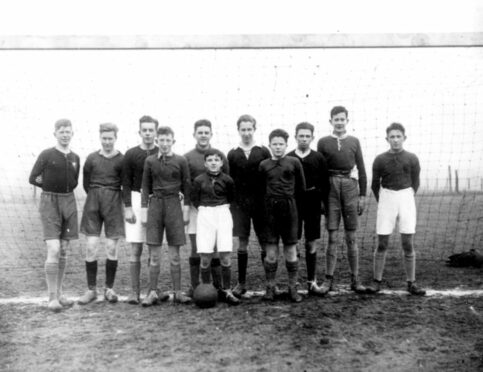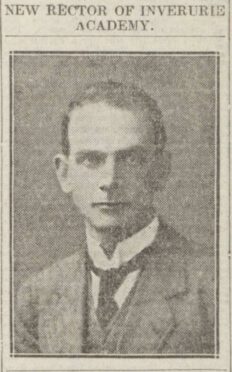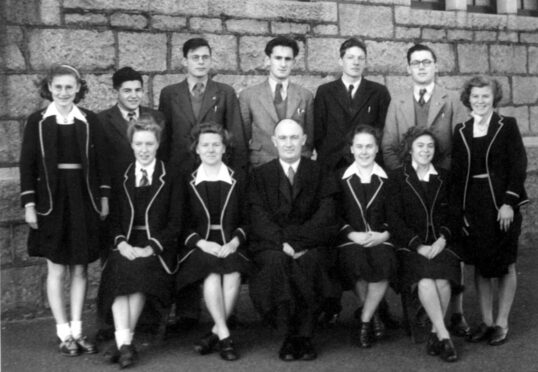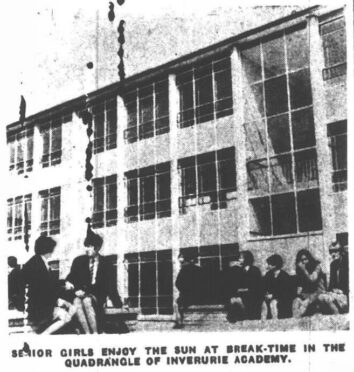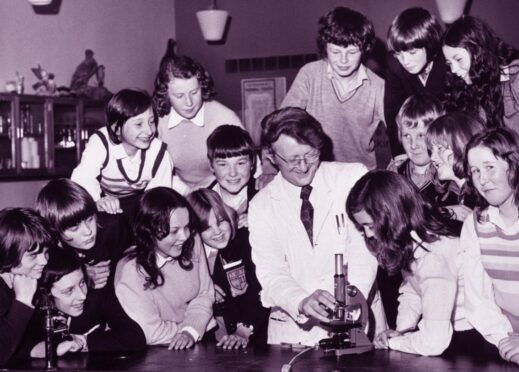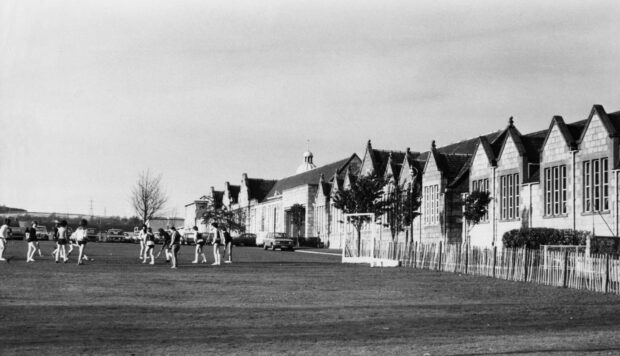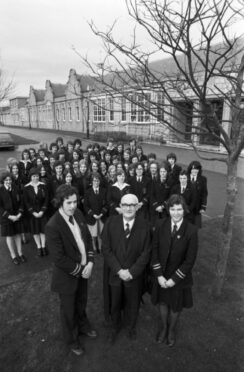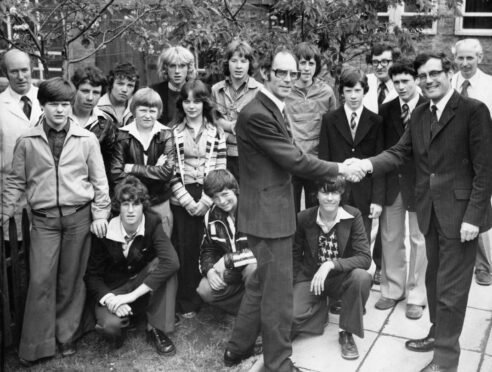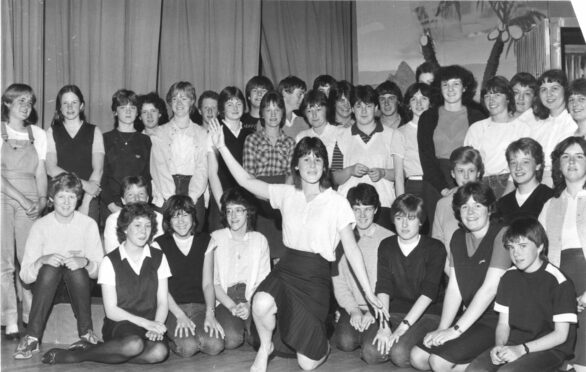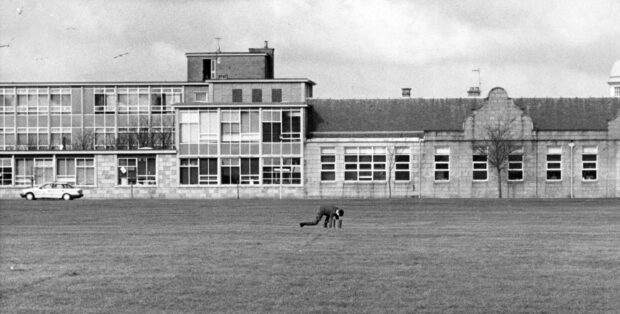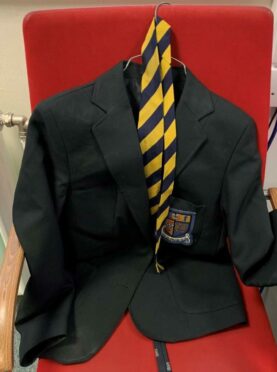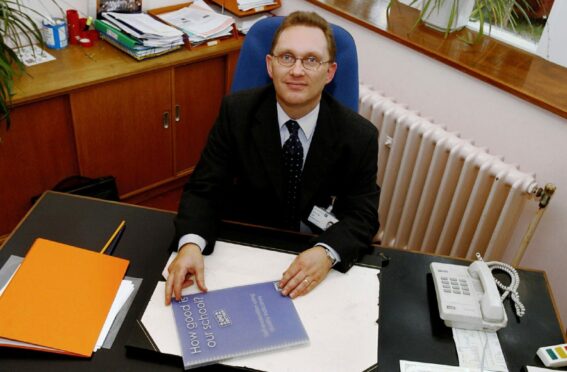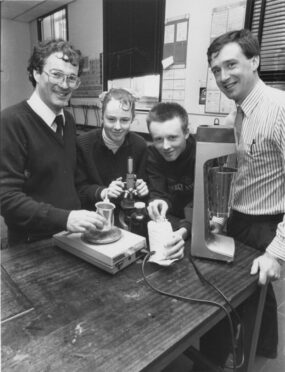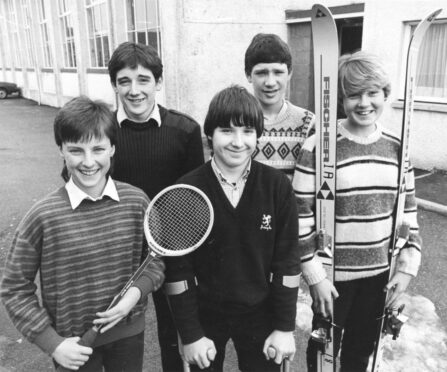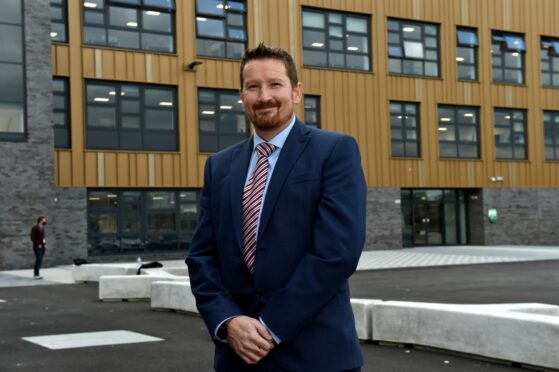The complete demolition of the old Inverurie Academy building edges ever closer, nearly 120 years on from its grand opening.
Over the last few months, the landscape of Inverurie town centre has changed dramatically as the academy has gradually been pulled down after standing for decades.
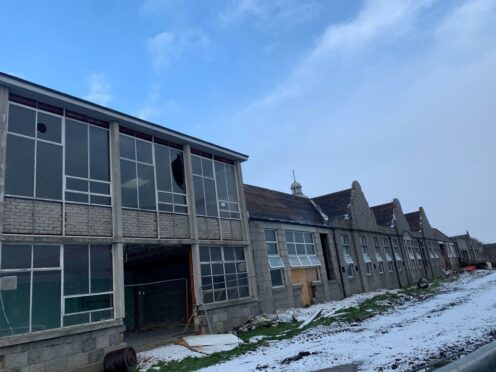
The old school became defunct when the new Inverurie Community Campus opened last year.
The first buildings to come down were the old 1960s canteen and technical department, swiftly followed by the history and languages blocks.
Now construction workers are taking apart the original Edwardian granite buildings slate by slate.
‘Palatial buildings’
When the Earl of Kintore laid the memorial stone in 1902, he praised the “substantial and commodious” new Inverurie Public School building.
Speaking to a crowd of townsfolk, he said: “I hope that within its walls will be educated not only the children of the present citizens of Inverurie, but also their grandchildren and great-grandchildren, and that it will be a building still in use at the close of the century.”
In a cavity above the memorial stone, a leaden casket was placed as a time capsule, in which there were coins, a history of the school, the history of the burgh and its dignitaries, and newspapers.
It was said that the Earl was “opening a new chapter in the academic or scholastic history of Inverurie” to meet an ever-increasing population of children.
The town’s population had risen to more than 4000 with the arrival of the Loco Works, and the new school was to have 11 classrooms, a central hall, staff rooms, cloakrooms and heating – at a cost of £7000.
And on August 31 1903 the school was officially opened by Alexander Asher MP.
He told the assembled crowd that when they “looked around at the palatial buildings and remembered the somewhat bare and uncomfortable rooms in which many of them were educated, he thought they might perhaps wish that they were all bairns again and going back to school tomorrow”.
He added: “But I do not begrudge the children the beautiful, bright airy rooms that have been provided and all the elaborate apparatus that had been secured for their education.”
Ferocious fire
But disaster struck 12 weeks later when a devastating fire broke out at the new Inverurie public school.
It was thought an overheating furnace flue near the roof sparked the blaze just 15 minutes after the evening class finished at 9.15pm.
The north wing and central hall ignited quickly and despite the fire brigade being on the scene within minutes, a scarcity of water made it impossible to get the inferno under control.
At 10pm the Loco Works’ fire horn was sounded and the railway fire brigade sprung into action, while a crowd of spectators in the playground did their best to rescue furniture.
A report in the Press and Journal on November 27 1903 said: “It was realised that the whole building was doomed, and the flames gradually spread until almost the whole building was destroyed.
“It has been stated that this school was one of the finest in the north of Scotland and one of the best equipped.”
But thanks to quick-thinking firefighters, three classrooms on the south elevation were spared.
The decision was taken to cut away the roof that joined the classrooms to the corridor to prevent the fire spreading, although in the aftermath the rest of building was said to resemble “a ruined cathedral”.
New chapter
By January 1905, the derelict buildings had been replaced and Inverurie Public School was again able to welcome scholars.
The town’s population continued to grow and a large extension was added to the school in 1908.
It was reclassified as a higher grade school, and renamed Inverurie Academy.
The increased academic accommodation included a large laboratory and a specially-equipped art room, and was opened by Dr Dunn, His Majesty’s Chief Inspector of Schools in Aberdeen.
The school still existed across two buildings – one that took pupils to the statutory school leaving age of 14 and the other which schooled teens for further education.
Inverurie Academy continued to go from strength to strength, with intelligent pupils from across the north-east sent to Inverurie to the upper school to progress their education.
It quickly gained a reputation as a ‘university feeder school’ with inspection reports deeming the level of teaching “very satisfactory”.
But like towns and villages across the country, Inverurie Academy suffered losses during the First World War both through conscription of staff into the armed forces, and casualties in battle.
It would have been a source of regret for rector James Philip – who had been headmaster at Inverurie since it opened – to see these bright young minds lost in battle.
The school community was in mourning once again in 1922 following the death of beloved Mr Philip.
The rector had retired in 1921 due to ailing health and passed away the following year.
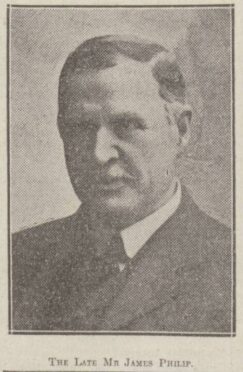
His obituary read: “Mr Philip ever found his work a pleasure; the teachers were his friends, and the pupils, to whom he was the most approachable of men, his special care.
“He was a teacher of the first rank, and was particularly able as a tutor of English.”
He was succeeded by Dr Gordon Lawson.
Legendary Dr Dixon
Dr Lawson found himself steering the academy through the war years, again witnessing the loss of former pupils.
But on the home front, the school became involved in raising money for war funds, as well as running make do and mend classes in the domestic science department.
Change came again in 1948 upon the retirement of Dr Lawson and the appointment of the legendary Dr Norman Dixon – a name that remains synonymous with Inverurie Academy.
In the 1950s he oversaw the school roll rising to a record high of more than 1300 pupils – but there were more scholars than could fit into the buildings.
Youngsters found themselves taking lessons in other halls throughout Inverurie, so plans for an extension began in earnest in 1957, but it would be 1967 before the work was finished.
Alterations were made to existing buildings and modern blocks were built housing 23 new classrooms, three labs, an assembly hall, dining hall, kitchen, technical department and medical suite.
Former pupils might remember the unusual addition to the school’s quad in 1971 – a flock of peacocks introduced to build an educational link between the school and Hazlehead Petting Zoo.
Teens of the 1970s will also remember with fondness, and perhaps some fear, teachers like ‘Tiger’ Thomson who taught languages and much-loved geography teaching duo “Ma and Pa Rodgers”.
Other familiar names were head of music James Lobban, Miss Fowler and deputy rector Douglas Prosser.
By the time Dr Dixon retired in March 1976, the school roll was 1548 – more than double the roll he started with – and he “prided himself” in knowing every pupil by name.
In his time at Inverurie, education had changed greatly with the introduction of the comprehensive schooling system and O Grades.
Dr Dixon sadly died four years later, but left a lasting impression on pupils and the school.
The trees he had planted around the playing field to commemorate successive school captains stood tall until they were cut down last year.
Bomb squad called
Alasdair Hogg succeeded Dr Dixon and quickly got to work making a case for another extension at the increasingly at-capacity school.
Mr Hogg argued the quality of education was suffering through inadequate buildings and that Inverurie Academy was the ‘Cinderella’ of Grampian.
In fact some of the older buildings were described as “over crowded, dingy, decrepit and often downright dangerous”.
Mr Hogg’s wish was granted in 1987 when a £2 million three-storey building opened, housing an open-plan English department, Home Economics and a library.
Another memorable moment in Mr Hogg’s tenure came in 1989 when pupil Stuart Largue brought a hand grenade to school – via his school bus – to show his registration teacher.
When it was discovered the pin was missing, 1100 pupils were sent home, all roads to the school cordoned off and neighbouring buildings evacuated.
Brave deputy rector Eric Brew put the grenade in a bucket and gingerly carried it to the school playing field while awaiting the arrival of the bomb squad from Edinburgh.
Explosive experts discovered the device “could have gone off at any time” and a controlled blast was carried out.
Mr Hogg said “it could have been a disaster”, while young Stuart said “it was like something out of Rambo”.
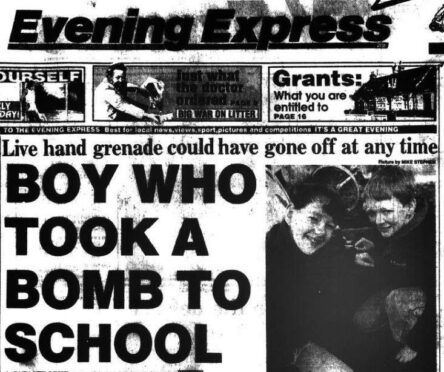
Fond farewells
The 90s brought more change; the old school uniform was out and casual dress was in.
In 1996, Dr Dixon’s old schoolhouse, which stood just within the perimeter at the top of School Lane, was taken down brick by brick and rebuilt in Tarves.
The end of the decade brought the end of the century and Mr Hogg retired, meaning in nearly 100 years, the school had only had four different rectors.
Next to take up the mantle and take Inverurie Academy into the new millennium was Douglas Milne who quickly brought back uniform.
For 12 years Mr Milne was head – and the last to have had more than 1200 pupils under his charge.
The opening of Meldrum Academy in 2002 diverted pupils from the Inverurie catchment meaning the class of 2000-2006 was the last intake of Oldmeldrum pupils at Inverurie.
Mr Milne stepped down and moved into another council role in 2012, and history was made when Inverurie Academy appointed its first female head teacher, Linda Evans.
It was a role she continued in until current rector Mark Jones took up the post in January 2017, ready to embark on perhaps the biggest change and challenge in the school’s history.
For years there had been talks about replacing Inverurie Academy with buildings no longer fit for modern curricula.
In 2018, work began on a new school to be built as part of a £54m community campus on the old school’s playing fields.
After some delays in the construction, pupils were due to move into the new building at Easter in 2020 – but then Covid-19 struck.
Like every other school in Britain, Inverurie Academy pupils and staff had to navigate the challenges of virtual learning during lockdown.
When restrictions eased, pupils returned to the old buildings after summer 2020, but there was joy in October when the move was finally made to the new campus.
Now as the development moves into the next phase the historic buildings that tens of thousands of pupils were educated in are being demolished.
But within the new campus the spirit of 120 years of education continues, reflecting the school’s heraldic motto Spiritus Intus Alit: the spirit within sustains.
If you enjoyed this, you might like:
